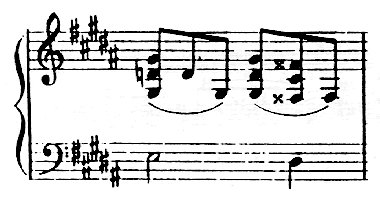The Rightness of Gurney

RODERIC DUNNETT continues his examination
of Ivor Gurney the musician
<< Continued from page 5
Instilling 'disquiet' is as integral to ballad-composing as to ballad-writing.
The eerie, 'distempered' feel of ballad is something Gurney captures especially
well in some of his best songs, often reaching out well beyond the traditional,
slightly four-square, four-in-a-bar ballad framework to achieve his effect.
Even among the best known published songs - 'The Twa Corbies', 'Edward'
and so on - there are examples aplenty. One of his finest achievements -
related in mood and genre, though like 'Last Hours' not a ballad as such
- is another Wilfrid Gibson song, 'All Night Under the Moon'.
The restlessness at the outset is achieved in several ways: the dark
G sharp minor key, emphasised all the more (as often with Gurney) by an
avoidance of placing the tonic note (here G sharp) on the main beat, instead
throwing it onto the off-beat. The initial disquiet is simply and even more
effectively maintained by the introduction of the note E - the minor sixth
of the scale - almost nonchalantly in the accompaniment (bar 2) on the second
offbeat: the weakest, most surreptitious spot in a 3/4 bar.
If unease hangs in the air, it is only increased by the arrival of the
vocal line. The process continues: that disquieting E is now displaced to
a crotchet on the second beat, only immediately to be telescoped, or echoed,
in the third beat triplet ('under the'). By bar four, the E has settled
firmly, succubus-like, on the first beat as root bass.
These simple devices, encompassed within the space of a mere few bars,
achieve their desired end: a kind of psychological restlessness is set up,
not altogether unlike that found in some darker Brahms keyboard intermezzi
- even though the fourth bar also introduces the kind of routinely imitated
Brahmsian figure

'All night Under the Moon' (Songs 1, p.15)
whose use by Gurney (see also the preludes) as a kind of mannered padding
can occasionally detract from, rather than enhance, his writing for the
piano.
These opening two lines of 'All Night under the Moon' also illustrate
another intriguing Gurney feature: his habit of building into his tunes
slightly curious, asymmetrical arches spanning or incorporating a full octave:
not necessarily starting and ending on the tonic (compare the opening and
close of 'The Fields are Full') or dominant (as here, D sharp-D sharp);
as commonly it may be a supertonic or leading note, or more likely still,
a flattened seventh. Compare the extended melody line of 'Desire in Spring'
(see the example above), where that same flattened seventh (a Gurney favourite)
is accorded special emphasis, underlined further by the word-setting ('love
... mothers': 'lonely ... twilight'). As often as not, these asymmetrical
octaves produce a curious, slightly lop-sided effect: a hallmark of Gurney's
style and melody, and one that is constantly rewarding and refreshing.
By the top of the second page, that initially wayward E natural of 'All
Night under the Moon' seems almost domesticated, or accommodated, by the
bar of E major ('meadows of'). We have travelled, emotionally speaking,
a long way in a few bars. All is not yet plain daylight, however: at 'calling
and crying', the nervous, irregular opening pattern adjusts once again:
the E natural shifts to the first offbeat, just preempting the voice ('calling');
the initial D sharp-G sharp pattern is itself reversed ('crying'); and an
additional intruder, an A sharp (the supertonic), gets thrown in, like a
passing bird cry, for good measure (the intruder is rapidly seen off, cancelled
out by the A naturals of the following bars.)
What follows is a curiously successful example of Gurney chromaticism,
as an emotionally charged vocal line gropes and feels its way back to the
G sharp minor of the start.
Those Yeatsian whisperings are, after all, benign: this is a night, shadows
and all, with which accommodation can be made.
As often, Gurney has been anticipating, telegraphing: he has set the
wires buzzing. For as Gibson's second stanza progresses, the mood becomes
increasingly affirmative, and it is for that wandering, restless sixth degree,
by some strange alchemy magically converted to an E sharp (major sixth)
where least expected, that he reserves the strongest moment of affirmation:
'Together we're flying' (see also 'hush of the night', where the E sharp
significantly recurs near the close of the song). The interval of a minor
sixth, key to the Yeatsian unease Gurney conjures up in this song, is time-hallowed
as an instrument of pathos - the rising interval of Dowland's Lachrymae
('Flow, my tears ...'), or the grieving alto solo 'It is finished' in the
St John Passion.
Gurney knows it well - witness the opening line of 'Sleep' (D flat-F;
D flat-B double flat).
Conscious, or unconscious? Artless, or artful, spontaneity? The source
of Gurney's canny, or uncanny, intuition for what sounds 'right' is continually
teasing and elusive. The 'Elizabethan' songs' true origins, as Michael Hurd
reminds us ('There are no obvious models for the Elizas': Ordeal,
p.39), are tantalisingly hard to pinpoint. Where did he get them
from - if not from the Elizabethans themselves? (Brahms's intermezzi and
organ preludes may again perhaps underlie the accompanimental figures).
Still, 'All Night under the Moon' is as crystalline and inspired, in its
own way, as his handling of 'Sleep', which itself seems plucked from another
world.
Continue >>
Copyright © 9 January 2000, Roderic
Dunnett, Coventry, UK
 << Music &
Vision homepage Leo Ornstein >>
<< Music &
Vision homepage Leo Ornstein >>
|